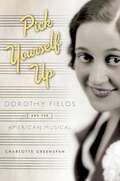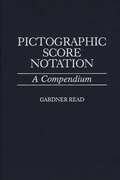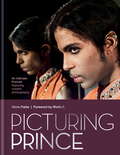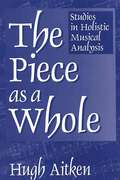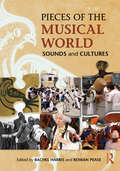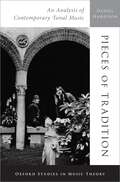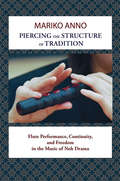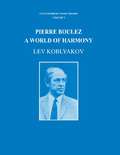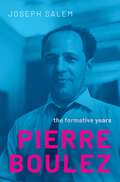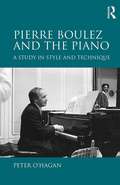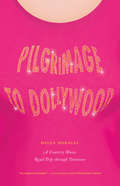- Table View
- List View
Pick Yourself Up: Dorothy Fields and the American Musical (Broadway Legacies)
by Charlotte GreenspanIn a career that spanned nearly five decades, Dorothy Fields penned the words to more than four hundred songs, among them mega-hits such as "On the Sunny Side of the Street," "I Can't Give You Anything But Love," "The Way You Look Tonight," and "If My Friends Could See Me Now." While Fields's name may be known mainly to connoisseurs, her contributions to our popular culture--indeed, our national consciousness--have been remarkable. In Pick Yourself Up, Charlotte Greenspan offers the most complete, serious treatment of Fields's life and work to date, tracing her rise to prominence in a male-dominated world.
Pick Yourself Up: Dorothy Fields and the American Musical (Broadway Legacies)
by Charlotte GreenspanIn a career that spanned nearly five decades, Dorothy Fields penned the words to more than four hundred songs, among them mega-hits such as "On the Sunny Side of the Street," "I Can't Give You Anything But Love," "The Way You Look Tonight," and "If My Friends Could See Me Now." While Fields's name may be known mainly to connoisseurs, her contributions to our popular culture--indeed, our national consciousness--have been remarkable. In Pick Yourself Up, Charlotte Greenspan offers the most complete, serious treatment of Fields's life and work to date, tracing her rise to prominence in a male-dominated world.
Pictographic Score Notation: A Compendium (Non-ser.)
by Gardner ReadThis text provides the first comprehensive examination of pictographic notation. Pictographic musical notation represents the relevant instruments themselves rendered visually rather than verbally. Used most extensively in contemporary publications between the 1950s and 1980s, its popularity has waned in recent years. This expertly researched work displays the resourcefulness and inventiveness of 20th century orchestrators.Providing a detailed examination of pictographic score notation, this unique book passes over 60 years of contemporary composition and score publications. Divided into three sections, this work describes instrumental pictographs, stage diagrams, and pictographic performance directives. In addition to the thoroughly researched information and extensive technique illustrations, commentary on individual examples and frequent cross-referencing of related examples, differentiate this work from other journal articles and notation texts.
Picturing Prince: An Intimate Portrait
by Steve ParkePICTURING PRINCE sees the late icon's former art director, STEVE PARKE, revealing stunning intimate photographs of the singer from his time working at Paisley Park. At least half of the images in the book are exclusively published here for the first time; most other images in the book are rare to the public eye.Alongside these remarkable images are fifty engaging, poignant and often funny written vignettes by Parke, which reveal the very human man behind the reclusive superstar: from shooting hoops to renting out movie theatres at 4am; from midnight requests for camels to meaningful conversations that shed light on Prince as a man and artist. STEVE PARKE started working with Prince in 1988, after a mutual friend showed Prince some of Steve's photorealistic paintings. He designed everything from album covers and merchandise to sets for Prince's tours and videos. Somewhere in all of this, he became Paisley Park's official art director. He began photographing Prince at the request of the star himself, and continued to do so for the next several years. The images in this book are the arresting result of this collaboration.
The Piece as a Whole: Studies in Holistic Musical Analysis
by Hugh AitkenDesigned to serve music students at the college level, this informal approach to music theory relates the technical aspects of music with the expressive character of the art. The approach is holistic in the sense that it focuses on the interrelationships between the piece as heard by a socially conditioned listener and the notated, performed score: it aims to bridge the gap between the technical and expressive aspects of music. The composers addressed are: Bach, Mozart, Beethoven, Chopin, Schumann, Brahms, Wagner, Debussy, and Schoenberg. There are separate chapters on the problems of meaning in music and on the interdependence of aesthetic and ethical value-judgments. This novel and exciting approach to music theory will be a welcome addition to the musical analysis literature.
Pieces of the Musical World: Sounds and Cultures
by Rachel Harris Rowan PeasePieces of the Musical World: Sounds and Cultures is a fieldwork-based ethnomusicology textbook that introduces a series of musical worlds each through a single "piece." It focuses on a musical sound or object that provides a springboard from which to tell a story about a particular geographic region, introducing key aspects of the cultures in which it is embedded, contexts of performance, the musicians who create or perform it, the journeys it has travelled, and its changing meanings. A collaborative venture by staff and research ethnomusicologists associated with the Department of Music at SOAS, University of London, Pieces of the Musical World is organized thematically. Three broad themes: "Place", "Spirituality" and "Movement" help teachers to connect contemporary issues in ethnomusicology, including soundscape studies, music and the environment, the politics of identity, diaspora and globalization, and music and the body. Each of the book's fourteen chapters highlights a single musical "piece" broadly defined, spanning the range of "traditional," "popular", "classical" and "contemporary" musics, and even sounds which might be considered "not music." Primary sources and a web site hosting recordings with interactive listening guides, a glossary of musical terms and interviews all help to create a unique and dynamic learning experience of our musical world.
Pieces of the Musical World: Sounds And Cultures
by Rachel Harris Rowan PeasePieces of the Musical World: Sounds and Cultures is a fieldwork-based ethnomusicology textbook that introduces a series of musical worlds each through a single "piece." It focuses on a musical sound or object that provides a springboard from which to tell a story about a particular geographic region, introducing key aspects of the cultures in which it is embedded, contexts of performance, the musicians who create or perform it, the journeys it has travelled, and its changing meanings. A collaborative venture by staff and research ethnomusicologists associated with the Department of Music at SOAS, University of London, Pieces of the Musical World is organized thematically. Three broad themes: "Place", "Spirituality" and "Movement" help teachers to connect contemporary issues in ethnomusicology, including soundscape studies, music and the environment, the politics of identity, diaspora and globalization, and music and the body. Each of the book's fourteen chapters highlights a single musical "piece" broadly defined, spanning the range of "traditional," "popular", "classical" and "contemporary" musics, and even sounds which might be considered "not music." Primary sources and a web site hosting recordings with interactive listening guides, a glossary of musical terms and interviews all help to create a unique and dynamic learning experience of our musical world.
Pieces of Tradition: An Analysis of Contemporary Tonal Music (Oxford Studies in Music Theory)
by Daniel HarrisonThis book is about how music "in a key" is composed. Further, it is about how such music was composed when it was no longer compulsory to do so, starting a few years before the First World War. In an eclectic journey through the history of compositional technique, Daniel Harrison contends that the tonal system did not simply die out with the dawn of twentieth century, but continued to supplement newer techniques as a compelling means of musical organization, even into current times. Well-known art music composers such as Bartok, Hindemith, Prokofiev, and Messiaen are represented alongside composers whose work moves outside the standard boundaries of art music: Leonard Bernstein, Murice Duruflé, Frank Martin, Xiaoyong Chen. Along the way, the book attends to military bugle calls, a trailer before a movie feature, a recomposition of a famous piece by Arnold Schoenberg, and the music of Neil Diamond, David Shire, and Brian Wilson. A celebration of the awesome variety of musical expressions encompassed in what is called tonal music, Pieces of Tradition is a book for composers seeking ideas and effects, music theorists interested in its innovations, and all those who practice the analysis of composition in all its modern and traditional variations.
Pieces of Tradition: An Analysis of Contemporary Tonal Music (Oxford Studies in Music Theory)
by Daniel HarrisonThis book is about how music "in a key" is composed. Further, it is about how such music was composed when it was no longer compulsory to do so, starting a few years before the First World War. In an eclectic journey through the history of compositional technique, Daniel Harrison contends that the tonal system did not simply die out with the dawn of twentieth century, but continued to supplement newer techniques as a compelling means of musical organization, even into current times. Well-known art music composers such as Bartok, Hindemith, Prokofiev, and Messiaen are represented alongside composers whose work moves outside the standard boundaries of art music: Leonard Bernstein, Murice Duruflé, Frank Martin, Xiaoyong Chen. Along the way, the book attends to military bugle calls, a trailer before a movie feature, a recomposition of a famous piece by Arnold Schoenberg, and the music of Neil Diamond, David Shire, and Brian Wilson. A celebration of the awesome variety of musical expressions encompassed in what is called tonal music, Pieces of Tradition is a book for composers seeking ideas and effects, music theorists interested in its innovations, and all those who practice the analysis of composition in all its modern and traditional variations.
Piercing the Structure of Tradition: Flute Performance, Continuity, and Freedom in the Music of Noh Drama
by Mariko AnnoWhat does freedom sound like in the context of traditional Japanese theater? Where is the space for innovation, and where can this kind of innovation be located in the rigid instrumentation of the Noh drama? In Piercing the Structure of Tradition, Mariko Anno investigates flute performance as a space to explore the relationship between tradition and innovation. This first English-language monograph traces the characteristics of the Noh flute (nohkan), its music, and transmission methods and considers the instrument's potential for development in the modern world. Anno examines the musical structure and nohkan melodic patterns of five traditional Noh plays and assesses the degree to which Issō School nohkan players maintain to this day the continuity of their musical traditions in three contemporary Noh plays influenced by Yeats. Her ethnographic approach draws on interviews with performers and case studies, as well as her personal reflection as a nohkan performer and disciple under the tutelage of Noh masters. She argues that traditions of musical style and usage remain influential in shaping contemporary Noh composition and performance practice, and the existing freedom within fixed patterns can be understood through a firm foundation in Noh tradition.
Pierre Boulez: A World of Harmony (Contemporary Music Studies #2)
by Lev KoblyakovFirst published in 1994. Routledge is an imprint of Taylor & Francis, an informa company.
Pierre Boulez: A World of Harmony (Contemporary Music Studies)
by Lev KoblyakovFirst published in 1994. Routledge is an imprint of Taylor & Francis, an informa company.
Pierre Boulez: The Formative Years
by Joseph SalemAs an integral figure in twentieth-century music, Pierre Boulez innovated new musical ideas through extraordinary creative processes. His formative years tracked his compositional development from his confrontations with serialism to drafting one of his major works, Pli selon pli, in the early 1960s. Part biography, part survey, Pierre Boulez: The Formative Years situates Boulez and his compositions among a complex network of influences. To best understand Boulez's creative process, author Joseph R. Salem organizes the book into three parts. First, Boulez's early life, training, and education provide biographical context for his career. Salem provides a fresh, revisionist perspective of the composer's life by drawing upon a mix of primary and secondary sources. Second, the brunt of the biography situates Boulez's musical works and experimentation among a host of contextual contexts. In place of scores and complicated musical analyses, Salem employs sketches as a visual metonym. The sketches denote Boulez's continual ability to self-reform, accept feedback from his peers, mentors, and family members, and revitalize old material. Third, Boulez's legacy is associated with contemporaneous aesthetic movements and artistic challenges. While his creative processes undoubtedly influenced music today, Boulez remains a controversial, even taboo, figure among contemporary musicians and audiences. A book that both celebrates and critiques its subject, The Formative Years urges a reconsideration of narratives and discussions surrounding Boulez's life and works.
Pierre Boulez: The Formative Years
by Joseph SalemAs an integral figure in twentieth-century music, Pierre Boulez innovated new musical ideas through extraordinary creative processes. His formative years tracked his compositional development from his confrontations with serialism to drafting one of his major works, Pli selon pli, in the early 1960s. Part biography, part survey, Pierre Boulez: The Formative Years situates Boulez and his compositions among a complex network of influences. To best understand Boulez's creative process, author Joseph R. Salem organizes the book into three parts. First, Boulez's early life, training, and education provide biographical context for his career. Salem provides a fresh, revisionist perspective of the composer's life by drawing upon a mix of primary and secondary sources. Second, the brunt of the biography situates Boulez's musical works and experimentation among a host of contextual contexts. In place of scores and complicated musical analyses, Salem employs sketches as a visual metonym. The sketches denote Boulez's continual ability to self-reform, accept feedback from his peers, mentors, and family members, and revitalize old material. Third, Boulez's legacy is associated with contemporaneous aesthetic movements and artistic challenges. While his creative processes undoubtedly influenced music today, Boulez remains a controversial, even taboo, figure among contemporary musicians and audiences. A book that both celebrates and critiques its subject, The Formative Years urges a reconsideration of narratives and discussions surrounding Boulez's life and works.
Pierre Boulez and the Piano: A Study in Style and Technique
by Peter O'HaganPierre Boulez's first piano pieces date from his youth, prior to his studies in Paris with Messiaen, and his subsequent meteoric rise to international acclaim as the leader of the musical avant-garde during the 1950s. His most recent published work is a solo piano piece, Une page d’éphéméride, written some sixty years after his first attempts at composition. The piano has remained central to Boulez's creative work throughout his career, and although his renown as a conductor has to some extent overshadowed his other achievements, it was as a performer of his own piano music that his practical gifts first found expression. Peter O'Hagan has given performances of various unpublished piano works by Boulez, including Antiphonie from the Third Sonata and Trois Psalmodies. In this study, he considers Boulez's writing for the piano in the context of the composer's stylistic evolution throughout the course of his development. Each of the principal works is considered in detail, not only on its own terms, but also as a stage in Boulez's ongoing quest to invent radical solutions to the renewal of musical language and to reinvigorate tradition. The volume includes reference to hitherto unpublished source material, which sheds light on his working methods and on the interrelationship between works.
Pierre Boulez and the Piano: A Study in Style and Technique
by Peter O'HaganPierre Boulez's first piano pieces date from his youth, prior to his studies in Paris with Messiaen, and his subsequent meteoric rise to international acclaim as the leader of the musical avant-garde during the 1950s. His most recent published work is a solo piano piece, Une page d’éphéméride, written some sixty years after his first attempts at composition. The piano has remained central to Boulez's creative work throughout his career, and although his renown as a conductor has to some extent overshadowed his other achievements, it was as a performer of his own piano music that his practical gifts first found expression. Peter O'Hagan has given performances of various unpublished piano works by Boulez, including Antiphonie from the Third Sonata and Trois Psalmodies. In this study, he considers Boulez's writing for the piano in the context of the composer's stylistic evolution throughout the course of his development. Each of the principal works is considered in detail, not only on its own terms, but also as a stage in Boulez's ongoing quest to invent radical solutions to the renewal of musical language and to reinvigorate tradition. The volume includes reference to hitherto unpublished source material, which sheds light on his working methods and on the interrelationship between works.
Pietro Von Abano (Selected Works of Louis Spohr, 1784-1859)
by Clive BrownVolume 3 of the SELECTED WORKS OF Louis Spohr 1784-1859- Pietro von Abano. At about this time one of his pupils, the twenty-three-year-old Carl Friedrich Curschmann, who had ambitions to compose an opera, showed Spohr a libretto that had been adapted from Ludwig Tieck's novel Pietro von Abano oder Petrus Apone, eine Zaubergeschichte (Breslau 1825) by the Kassel lawyer and poet Carl Pfeiffer. Spohr was immediately impressed by the libretto and, having dissuaded Curschmann from going ahead with the project, probably on the grounds that he was too inexperienced for such a major undertaking, he came to an agreement with Curschmann and Pfeiffer that he should set it himself. Including the plot, script and screenshots of the original music documents.
Pietro Von Abano (Selected Works of Louis Spohr, 1784-1859 #3)
by Clive BrownVolume 3 of the SELECTED WORKS OF Louis Spohr 1784-1859- Pietro von Abano. At about this time one of his pupils, the twenty-three-year-old Carl Friedrich Curschmann, who had ambitions to compose an opera, showed Spohr a libretto that had been adapted from Ludwig Tieck's novel Pietro von Abano oder Petrus Apone, eine Zaubergeschichte (Breslau 1825) by the Kassel lawyer and poet Carl Pfeiffer. Spohr was immediately impressed by the libretto and, having dissuaded Curschmann from going ahead with the project, probably on the grounds that he was too inexperienced for such a major undertaking, he came to an agreement with Curschmann and Pfeiffer that he should set it himself. Including the plot, script and screenshots of the original music documents.
Pilgrimage to Dollywood: A Country Music Road Trip through Tennessee (Culture Trails: Adventures in Travel)
by Helen MoralesA star par excellence, Dolly Parton is one of country music’s most likable personalities. Even a hard-rocking punk or orchestral aesthete can’t help cracking a smile or singing along with songs like “Jolene” and “9 to 5.” More than a mere singer or actress, Parton is a true cultural phenomenon, immediately recognizable and beloved for her talent, tinkling laugh, and steel magnolia spirit. She is also the only female star to have her own themed amusement park: Dollywood in Pigeon Forge, Tennessee. Every year thousands of fans flock to Dollywood to celebrate the icon, and Helen Morales is one of those fans. In Pilgrimage to Dollywood, Morales sets out to discover Parton’s Tennessee. Her travels begin at the top celebrity pilgrimage site of Elvis Presley’s Graceland, then take her to Loretta Lynn’s ranch in Hurricane Mills; the Country Music Hall of Fame and the Grand Ole Opry in Nashville; to Sevierville, Gatlinburg, and the Great Smoky Mountains National Park; and finally to Pigeon Forge, home of the “Dolly Homecoming Parade,” featuring the star herself as grand marshall. Morales’s adventure allows her to compare the imaginary Tennessee of Parton’s lyrics with the real Tennessee where the singer grew up, looking at essential connections between country music, the land, and a way of life. It’s also a personal pilgrimage for Morales. Accompanied by her partner, Tony, and their nine-year-old daughter, Athena (who respectively prefer Mozart and Miley Cyrus), Morales, a recent transplant from England, seeks to understand America and American values through the celebrity sites and attractions of Tennessee. This celebration of Dolly and Americana is for anyone with an old country soul who relies on music to help understand the world, and it is guaranteed to make a Dolly Parton fan of anyone who has not yet fallen for her music or charisma.
Pilgrimage to Dollywood: A Country Music Road Trip through Tennessee (Culture Trails: Adventures in Travel)
by Helen MoralesA star par excellence, Dolly Parton is one of country music’s most likable personalities. Even a hard-rocking punk or orchestral aesthete can’t help cracking a smile or singing along with songs like “Jolene” and “9 to 5.” More than a mere singer or actress, Parton is a true cultural phenomenon, immediately recognizable and beloved for her talent, tinkling laugh, and steel magnolia spirit. She is also the only female star to have her own themed amusement park: Dollywood in Pigeon Forge, Tennessee. Every year thousands of fans flock to Dollywood to celebrate the icon, and Helen Morales is one of those fans. In Pilgrimage to Dollywood, Morales sets out to discover Parton’s Tennessee. Her travels begin at the top celebrity pilgrimage site of Elvis Presley’s Graceland, then take her to Loretta Lynn’s ranch in Hurricane Mills; the Country Music Hall of Fame and the Grand Ole Opry in Nashville; to Sevierville, Gatlinburg, and the Great Smoky Mountains National Park; and finally to Pigeon Forge, home of the “Dolly Homecoming Parade,” featuring the star herself as grand marshall. Morales’s adventure allows her to compare the imaginary Tennessee of Parton’s lyrics with the real Tennessee where the singer grew up, looking at essential connections between country music, the land, and a way of life. It’s also a personal pilgrimage for Morales. Accompanied by her partner, Tony, and their nine-year-old daughter, Athena (who respectively prefer Mozart and Miley Cyrus), Morales, a recent transplant from England, seeks to understand America and American values through the celebrity sites and attractions of Tennessee. This celebration of Dolly and Americana is for anyone with an old country soul who relies on music to help understand the world, and it is guaranteed to make a Dolly Parton fan of anyone who has not yet fallen for her music or charisma.
Pilgrimage to Dollywood: A Country Music Road Trip through Tennessee (Culture Trails: Adventures in Travel)
by Helen MoralesA star par excellence, Dolly Parton is one of country music’s most likable personalities. Even a hard-rocking punk or orchestral aesthete can’t help cracking a smile or singing along with songs like “Jolene” and “9 to 5.” More than a mere singer or actress, Parton is a true cultural phenomenon, immediately recognizable and beloved for her talent, tinkling laugh, and steel magnolia spirit. She is also the only female star to have her own themed amusement park: Dollywood in Pigeon Forge, Tennessee. Every year thousands of fans flock to Dollywood to celebrate the icon, and Helen Morales is one of those fans. In Pilgrimage to Dollywood, Morales sets out to discover Parton’s Tennessee. Her travels begin at the top celebrity pilgrimage site of Elvis Presley’s Graceland, then take her to Loretta Lynn’s ranch in Hurricane Mills; the Country Music Hall of Fame and the Grand Ole Opry in Nashville; to Sevierville, Gatlinburg, and the Great Smoky Mountains National Park; and finally to Pigeon Forge, home of the “Dolly Homecoming Parade,” featuring the star herself as grand marshall. Morales’s adventure allows her to compare the imaginary Tennessee of Parton’s lyrics with the real Tennessee where the singer grew up, looking at essential connections between country music, the land, and a way of life. It’s also a personal pilgrimage for Morales. Accompanied by her partner, Tony, and their nine-year-old daughter, Athena (who respectively prefer Mozart and Miley Cyrus), Morales, a recent transplant from England, seeks to understand America and American values through the celebrity sites and attractions of Tennessee. This celebration of Dolly and Americana is for anyone with an old country soul who relies on music to help understand the world, and it is guaranteed to make a Dolly Parton fan of anyone who has not yet fallen for her music or charisma.
Pilgrimage to Dollywood: A Country Music Road Trip through Tennessee (Culture Trails: Adventures in Travel)
by Helen MoralesA star par excellence, Dolly Parton is one of country music’s most likable personalities. Even a hard-rocking punk or orchestral aesthete can’t help cracking a smile or singing along with songs like “Jolene” and “9 to 5.” More than a mere singer or actress, Parton is a true cultural phenomenon, immediately recognizable and beloved for her talent, tinkling laugh, and steel magnolia spirit. She is also the only female star to have her own themed amusement park: Dollywood in Pigeon Forge, Tennessee. Every year thousands of fans flock to Dollywood to celebrate the icon, and Helen Morales is one of those fans. In Pilgrimage to Dollywood, Morales sets out to discover Parton’s Tennessee. Her travels begin at the top celebrity pilgrimage site of Elvis Presley’s Graceland, then take her to Loretta Lynn’s ranch in Hurricane Mills; the Country Music Hall of Fame and the Grand Ole Opry in Nashville; to Sevierville, Gatlinburg, and the Great Smoky Mountains National Park; and finally to Pigeon Forge, home of the “Dolly Homecoming Parade,” featuring the star herself as grand marshall. Morales’s adventure allows her to compare the imaginary Tennessee of Parton’s lyrics with the real Tennessee where the singer grew up, looking at essential connections between country music, the land, and a way of life. It’s also a personal pilgrimage for Morales. Accompanied by her partner, Tony, and their nine-year-old daughter, Athena (who respectively prefer Mozart and Miley Cyrus), Morales, a recent transplant from England, seeks to understand America and American values through the celebrity sites and attractions of Tennessee. This celebration of Dolly and Americana is for anyone with an old country soul who relies on music to help understand the world, and it is guaranteed to make a Dolly Parton fan of anyone who has not yet fallen for her music or charisma.
Pilgrimage to Dollywood: A Country Music Road Trip through Tennessee (Culture Trails: Adventures in Travel)
by Helen MoralesA star par excellence, Dolly Parton is one of country music’s most likable personalities. Even a hard-rocking punk or orchestral aesthete can’t help cracking a smile or singing along with songs like “Jolene” and “9 to 5.” More than a mere singer or actress, Parton is a true cultural phenomenon, immediately recognizable and beloved for her talent, tinkling laugh, and steel magnolia spirit. She is also the only female star to have her own themed amusement park: Dollywood in Pigeon Forge, Tennessee. Every year thousands of fans flock to Dollywood to celebrate the icon, and Helen Morales is one of those fans. In Pilgrimage to Dollywood, Morales sets out to discover Parton’s Tennessee. Her travels begin at the top celebrity pilgrimage site of Elvis Presley’s Graceland, then take her to Loretta Lynn’s ranch in Hurricane Mills; the Country Music Hall of Fame and the Grand Ole Opry in Nashville; to Sevierville, Gatlinburg, and the Great Smoky Mountains National Park; and finally to Pigeon Forge, home of the “Dolly Homecoming Parade,” featuring the star herself as grand marshall. Morales’s adventure allows her to compare the imaginary Tennessee of Parton’s lyrics with the real Tennessee where the singer grew up, looking at essential connections between country music, the land, and a way of life. It’s also a personal pilgrimage for Morales. Accompanied by her partner, Tony, and their nine-year-old daughter, Athena (who respectively prefer Mozart and Miley Cyrus), Morales, a recent transplant from England, seeks to understand America and American values through the celebrity sites and attractions of Tennessee. This celebration of Dolly and Americana is for anyone with an old country soul who relies on music to help understand the world, and it is guaranteed to make a Dolly Parton fan of anyone who has not yet fallen for her music or charisma.
Pilgrimage to Dollywood: A Country Music Road Trip through Tennessee (Culture Trails: Adventures in Travel)
by Helen MoralesA star par excellence, Dolly Parton is one of country music’s most likable personalities. Even a hard-rocking punk or orchestral aesthete can’t help cracking a smile or singing along with songs like “Jolene” and “9 to 5.” More than a mere singer or actress, Parton is a true cultural phenomenon, immediately recognizable and beloved for her talent, tinkling laugh, and steel magnolia spirit. She is also the only female star to have her own themed amusement park: Dollywood in Pigeon Forge, Tennessee. Every year thousands of fans flock to Dollywood to celebrate the icon, and Helen Morales is one of those fans. In Pilgrimage to Dollywood, Morales sets out to discover Parton’s Tennessee. Her travels begin at the top celebrity pilgrimage site of Elvis Presley’s Graceland, then take her to Loretta Lynn’s ranch in Hurricane Mills; the Country Music Hall of Fame and the Grand Ole Opry in Nashville; to Sevierville, Gatlinburg, and the Great Smoky Mountains National Park; and finally to Pigeon Forge, home of the “Dolly Homecoming Parade,” featuring the star herself as grand marshall. Morales’s adventure allows her to compare the imaginary Tennessee of Parton’s lyrics with the real Tennessee where the singer grew up, looking at essential connections between country music, the land, and a way of life. It’s also a personal pilgrimage for Morales. Accompanied by her partner, Tony, and their nine-year-old daughter, Athena (who respectively prefer Mozart and Miley Cyrus), Morales, a recent transplant from England, seeks to understand America and American values through the celebrity sites and attractions of Tennessee. This celebration of Dolly and Americana is for anyone with an old country soul who relies on music to help understand the world, and it is guaranteed to make a Dolly Parton fan of anyone who has not yet fallen for her music or charisma.
Pilgrimage to Dollywood: A Country Music Road Trip through Tennessee (Culture Trails: Adventures in Travel)
by Helen MoralesA star par excellence, Dolly Parton is one of country music’s most likable personalities. Even a hard-rocking punk or orchestral aesthete can’t help cracking a smile or singing along with songs like “Jolene” and “9 to 5.” More than a mere singer or actress, Parton is a true cultural phenomenon, immediately recognizable and beloved for her talent, tinkling laugh, and steel magnolia spirit. She is also the only female star to have her own themed amusement park: Dollywood in Pigeon Forge, Tennessee. Every year thousands of fans flock to Dollywood to celebrate the icon, and Helen Morales is one of those fans. In Pilgrimage to Dollywood, Morales sets out to discover Parton’s Tennessee. Her travels begin at the top celebrity pilgrimage site of Elvis Presley’s Graceland, then take her to Loretta Lynn’s ranch in Hurricane Mills; the Country Music Hall of Fame and the Grand Ole Opry in Nashville; to Sevierville, Gatlinburg, and the Great Smoky Mountains National Park; and finally to Pigeon Forge, home of the “Dolly Homecoming Parade,” featuring the star herself as grand marshall. Morales’s adventure allows her to compare the imaginary Tennessee of Parton’s lyrics with the real Tennessee where the singer grew up, looking at essential connections between country music, the land, and a way of life. It’s also a personal pilgrimage for Morales. Accompanied by her partner, Tony, and their nine-year-old daughter, Athena (who respectively prefer Mozart and Miley Cyrus), Morales, a recent transplant from England, seeks to understand America and American values through the celebrity sites and attractions of Tennessee. This celebration of Dolly and Americana is for anyone with an old country soul who relies on music to help understand the world, and it is guaranteed to make a Dolly Parton fan of anyone who has not yet fallen for her music or charisma.
